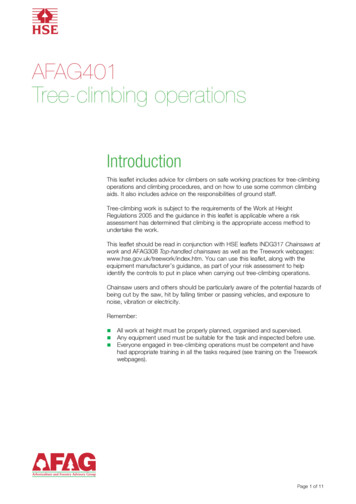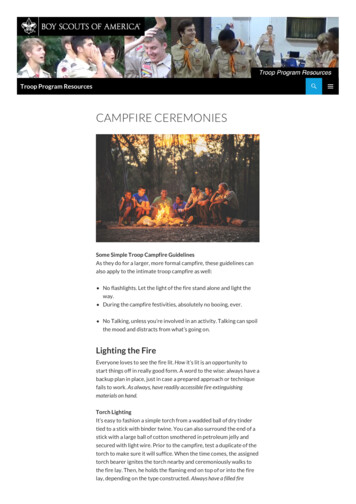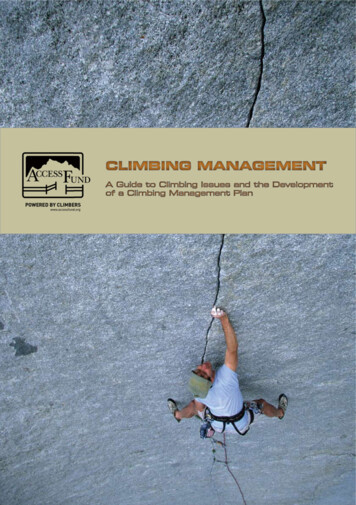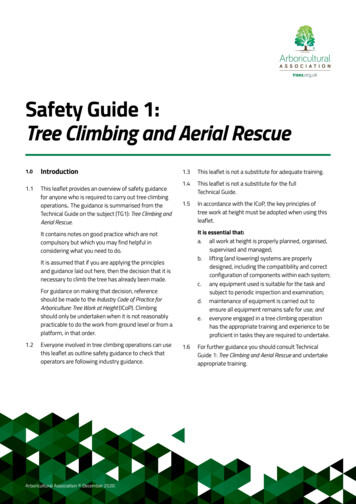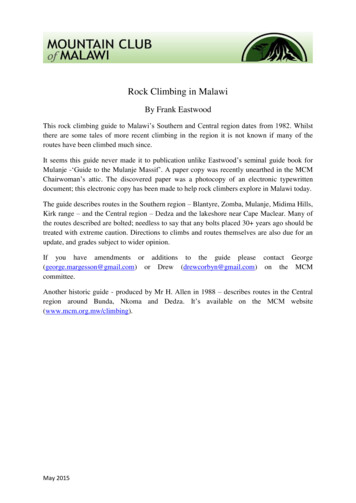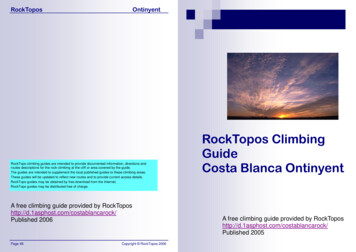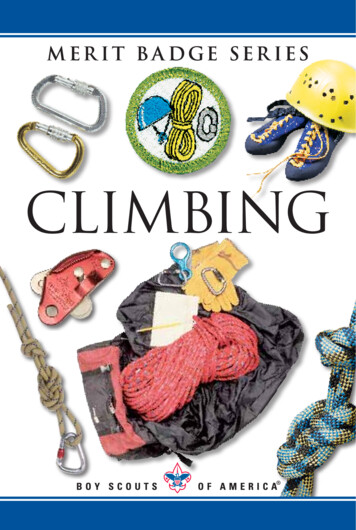
Transcription
climbing
BOY SCOUTS OF AMERICAMERIT BADGE SERIESCLIMBING
Note to the CounselorYoung people today seek greater challenges, and climbing andrappelling offer a worthy challenge. The satisfaction of safelyclimbing a rock face is hard to top. While introduction of theClimbing merit badge in 1997 spurred interest in these activitiesthrough the Boy Scouts of America, the proliferation of climbing gyms and facilities has also made climbing and rappellingreadily available throughout the United States.This increased interest has made the BSA more aware ofthe inherent risks of climbing and rappelling. More accidentsoccur during unit rappelling than during council-managedclimbing or rappelling, and more accidents have occurredduring rappelling than climbing. Many climbing and rappellingaccidents could be avoided by having qualified instruction froma conscientious adult who has the attention and respect of theyouth entrusted to his or her care. Supervision by a caring adultwho fully understands and appreciates the responsibility he orshe assumes helps assure safety when youth engage in orprepare for climbing or rappelling.The adult supervisor’s relationship with youth shouldreinforce the importance of following instructions. The adultleader in charge and the climbing instructor share this responsibility. The instructor is responsible for all procedures and forsafely conducting the climbing/rappelling activity. The adultsupervisor works cooperatively with the climbing instructorand is responsible for all matters outside of the climbing/rappelling activity.35873ISBN 978-0-8395-5001-3 2006 Boy Scouts of America2008 Printing
Climb On Safely is the Boy Scouts of America’srecommended procedure for organizingBSA unit climbing/rappelling activities at anatural site or a specifically designed facilitysuch as a climbing wall or tower.Topping Out: A BSA Climbing/Rappelling Manual,No. 32007, is the most authoritative guide currently availablefrom the Boy Scouts of America. Mountaineering: The Freedomof the Hills, sixth or seventh edition, edited by Don Graydonand Kurt Hanson, is a recommended reference for specific questions not covered in BSA literature. Passport to High Adventure,No. 34245, published by the BSA, is an appropriate guidebookto safely get your unit to and from the climbing/rappelling site.Units that elect to participate in lead climbing and snowand ice climbing are required to receive training from a nationally recognized organization that trains climbing and rappellinginstructors. All council and district climbing must comply withBSA Climbing/Rapelling National Standards (No. 20-102), andmust be top-roped.Each of the following points plays an important role in theoverall Climb On Safely program. Fun and safe climbing/rappelling activities require close compliance of Climb On Safely bythe adult supervisor and instructor. These points also apply tobouldering—traversing a few feet above ground level.1. Qualified Supervision. All climbing and rappelling must besupervised by a mature, conscientious adult at least 21 yearsof age who understands the risks inherent to these activities.This person knowingly accepts responsibility for the wellbeing and safety of the youth in his or her care. This adultsupervisor is trained in and committed to compliance withthe eight points of the Boy Scouts of America’s Climb OnSafely procedure. One additional adult who is at least 18years of age must also accompany the unit. Units with morethan 10 youths in the same climbing/rappelling sessionmust have an additional adult leader at least 18 years of agefor each 10 additional youth participants. In other words, agroup of 11 to 20 youths requires at least three adult leaders;a group of 21 to 30 youths would require four adult leaders,and so on.CLIMBING3
The adult supervisor is responsible for ensuring thatsomeone in the group is currently trained in AmericanRed Cross Standard First Aid and CPR (a 61/2-hour course).In addition, Wilderness First Aid Basic (a 16-hour course)is recommended for units going to remote areas. A courseof equivalent length and content from another nationallyrecognized organization can be substituted. A higher levelof certification such as emergency medical technician (EMT),licensed practical nurse (LPN), registered nurse (RN), andlicensed health-care practitioner is also acceptable. TheARC’s Emergency Response, a 431/2-hour course thatincludes CPR, is highly recommended.2. Qualified Instructors. A qualified rock climbing instructorwho is at least 21 years of age must supervise all BSAclimbing/rappelling activities. A currently trained BSAclimbing director or instructor is highly recommended.Contact your local council or regional service center tolocate a qualified individual. The climbing instructorhas successfully completed a minimum of 10 hours ofinstructor training for climbing/rappelling from a nationallyor regionally recognized organization, a climbing school,or a college-level climbing/rappelling course.4CLIMBING
The BSA offers a section of National Camping School forclimbing directors who in turn can train climbing instructors. Contact your local council or regional service center fora schedule of National Camping Schools. Every instructormust have prior experiences in teaching climbing/rappellingto youth and must agree to adhere to Climb On Safely andthe guidelines in Topping Out.A capable instructor has experience in teaching climbingand rappelling to youth, acknowledges personal limitations,and exercises good judgment in a variety of circumstances.The person who just spent four days of free-solo climbingon a sheer rock face may have technical skills but may lackteaching ability or the ability to empathize with youth whomay be apprehensive about climbing.Examples of sources of qualified climbing and rappellinginstructors include, but are not limited to, the following: BSA climbing directors or instructors National Outdoor Leadership School Wilderness Education Association American Mountain Guides Association The Mountaineers Recreational Equipment Inc. Eastern Mountain Sports University or college climbing/rappelling instructorsor students National Speleological Society chaptersLeaders and instructors should also consult current literatureon climbing and rappelling for additional guidance.3. Physical Fitness. Require evidence of fitness for the climbing/rappelling activity with at least a current BSA PersonalHealth and Medical Record—Class 1, No. 34414. A fitnessregimen is recommended prior to participation in climbing/rappelling. The adult supervisor should adapt all supervision, discipline, and precautions to anticipate any potentialrisks associated with individual health conditions.CLIMBING5
If a significant health condition is present, an examination bya licensed health-care practitioner should be required by theadult supervisor before permitting participation in climbingor rappelling. The adult supervisor should inform the climbing instructor about each participant’s medical conditions.4. Safe Area. All BSA climbing/rappelling activities must beconducted using an established climbing/rappelling site orfacility, including a portable or commercial facility. A qualified climbing instructor should survey the site in advance ofthe activity to identify and evaluate possible hazards and todetermine whether the site is suitable for the age, maturity,and skill level of the participants. The instructor should alsoverify that the site is sufficient to safely and comfortablyaccommodate the number of participants in the activitywithin the available time. An emergency evacuation routemust be identified in advance.5. Equipment. The climbing instructor should verify thatthe proper equipment is available for the size and abilitylevel of participants. Helmets, rope, and climbing hardwaremust be approved by the UIAA (Union Internationale desAssociations d’ Alpinisme) or CE (European CommunityNorm), or meet ASTM (American Society for Testing andMaterials) standards. All equipment must be acquired newor furnished by the instructor.An approved climbing helmet mustbe worn during all BSA climbing/rappelling activities where theparticipant’s feet are morethan shoulder heightabove ground level.When using a commercial climbinggym, the climbingfacility’s equipmentprocedures apply.6CLIMBING
6. Planning. When planning, remember the following: Obtain written parental consent to participate inclimbing/rappelling activities for each participant.The concept of In the event of severe weather or other problems, sharethe climbing/rappelling plan and an alternate withparents and the unit committee.choice applies Secure the necessary permits or written permission forusing private or public lands. Enlist the help of a qualified climbing instructor.challenge byto all climbing/rappelling activities.No one should Be sure the instructor has a map for the area being usedand obtains a current weather report for the area beforethe group’s departure.be forced orIt is suggested that at least one of the adult leaders has anelectronic means of communication in case of an emergency.Before any activity, an adult leader should develop andshare an emergency plan that includes the location of anearby medical facility and the means of communicatingwith parents during the outing.with which hepressured intodoing somethingor she is notcomfortable.7. Environmental Conditions. The instructor, each adultleader, and each participant assume responsibility formonitoring potentially dangerous environmental conditionsthat may include loose, crumbly rock; poisonous plants;wildlife; and inclement weather. Use the buddy system tomonitor concerns such as dehydration, hypothermia, andan unusually high degree of fear or apprehension. The adultsupervisor is responsible for ensuring that the group leavesno trace of its presence at the site. See the Principles ofLeave No Trace, No. 21-105.8. Discipline. Each participant knows, understands, andrespects the rules and procedures for safely climbing andrappelling and has been oriented in Climb On Safely andLeave No Trace. All BSA members should respect andfollow all instructions and rules of the climbing instructor.The applicable rules should be presented and learned priorto the outing and should be reviewed for all participantsbefore climbing or rappelling begins. When participantsknow the reasons for rules and procedures, they are morelikely to follow them. The climbing instructor must bestrict and fair, showing no favoritism.CLIMBING7
Requirements1. Do the following:a. Show that you know first aid for and how to preventinjuries or illnesses that could occur during climbingactivities, including heat and cold reactions, dehydration,stopped breathing, sprains, abrasions, fractures, ropeburns, blisters, snakebite, and insect bites or stings.b. Identify the conditions that must exist before performingCPR on a person.2. Learn the Leave No Trace principles and Outdoor Code, andexplain what they mean.3. Present yourself properly dressed for belaying, climbing,and rappelling (i.e., appropriate clothing, footwear, and ahelmet; rappellers and belayers must also wear gloves).4. Location. Do the following:a. Explain how the difficulty of climbs is classified, andapply classifications to the rock faces or walls where youwill demonstrate your climbing skills.b. Explain the following: top-rope climbing, lead climbing,and bouldering.c. Evaluate the safety of a particular climbing area.Consider weather, visibility, the condition of the climbingsurface, and any other environmental hazards.d. Determine how to summon aid to the climbing area incase of an emergency.8CLIMBING
5. Verbal signals. Explain the importance of using verbalsignals during every climb and rappel, and while bouldering. With the help of the merit badge counselor or anotherScout, demonstrate the verbal signals used by each ofthe following:a. Climbersb. Rappellersc. Belayersd. Boulderers and their spotters6. Rope. Do the following:a. Describe the kinds of rope acceptable for use in climbingand rappelling.b. Show how to examine a rope for signs of wearor damage.c. Discuss ways to prevent a rope from being damaged.d. Explain when and how a rope should be retired.e. Properly coil a rope.7. Knots. Demonstrate the ability to tie each of the followingknots. Give at least one example of how each knot is usedin belaying, climbing, or rappelling.a. Figure eight on a bightb. Figure eight follow-throughc. Water knotd. Double fisherman’s knot (grapevine knot)e. Safety knot8. Harnesses. Correctly put on at least ONE of the following:a. Commercially made climbing harnessb. Tied harnessCLIMBING9
9. Belaying. Do the following:a. Explain the importance of belaying climbers andrappellers and when it is necessary.b. Belay three different climbers ascending a rock face orclimbing wall.c. Belay three different rappellers descending a rock faceor climbing wall using a top rope.10. Climbing.a. Show the correct way to directly tie into a belay rope.b. Climb at least three different routes on a rock face orclimbing wall, demonstrating good technique and usingverbal signals with a belayer.11. Rappelling.a. Using a carabiner and a rappel device, secure yourclimbing harness to a rappel rope.b. Tie into a belay rope set up to protect rappellers.c. Rappel down three different rock faces or three rappelroutes on a climbing wall. Use verbal signals tocommunicate with a belayer, and demonstrate goodrappelling technique.12. Demonstrate ways to store rope, hardware, and other gearused for climbing, rappelling, and belaying.10CLIMBING
ContentsIntroduction . . . . . . . . . . . . . . . . . . . . . . . . . . . . . . . . . . . . . 12Getting Started . . . . . . . . . . . . . . . . . . . . . . . . . . . . . . . . . . . 18Risk Management and First Aid. . . . . . . . . . . . . . . . . . . . . . . 25Climbing Smart: The Where and When. . . . . . . . . . . . . . . . . 33Clothing and Equipment. . . . . . . . . . . . . . . . . . . . . . . . . . . . 38Knots . . . . . . . . . . . . . . . . . . . . . . . . . . . . . . . . . . . . . . . . . . 50Harnesses, Anchors, and Belay Systems. . . . . . . . . . . . . . . . . 54Climbing. . . . . . . . . . . . . . . . . . . . . . . . . . . . . . . . . . . . . . . . 71Rappelling. . . . . . . . . . . . . . . . . . . . . . . . . . . . . . . . . . . . . . . 85Climbing Ethics. . . . . . . . . . . . . . . . . . . . . . . . . . . . . . . . . . . 88Climbing Terminology. . . . . . . . . . . . . . . . . . . . . . . . . . . . . . 90Climbing Resources. . . . . . . . . . . . . . . . . . . . . . . . . . . . . . . . 94CLIMBING11
Introduction.“When man pitshimself againstthe mountain, hetaps inner springsof his strength.He comes toknow himself.”—William O.Douglas, mountainclimber andU.S. SupremeCourt justiceIntroduction“On belay?” you shout, and give the rope tied to your seatharness a final inspection.Far above you, at the top of a steep cliff, your partneranswers, “Belay on!”“Climbing!” you respond and then listen for your partnerto reply, “Climb on!”You reach up and lock your fingers over a nub of rock,then place your foot in a small depression. Leaning out fromthe cliff as you push up with your foot and leg, you find ahigher spot to place your other foot. You jam your free handinto a narrow crack and move your other hand up from thenub to grab a thin ledge.Another foothold, another hand placement, and you aremoving smoothly up the rock. There is nothing but empty airbelow you and open sky above, and your confidence soars.If you slip, your partner will lock off the belay rope and keepyou from falling more than a few feet.But you won’t fall this time. You’ve been practicing hard,and you feel at home in this vertical world. With grace andskill, you glide from one hold to the next, always looking aheadto plan your next moves.A cool wind blows against your face and thesun warms your shoulders. You respect the heightbut do not fear it. As you near the top of thecliff, you are in control, using every bit of yourability and concentration to make your way upthe wall of rock.With a final move, you lift yourself to the topof the cliff as your partner takes in slack from therope. “Belay off,” you say when you reach a safe place,and wait for the answer: “Off belay.” You have successfullyclimbed 30, 40, 50 feet or more. You’re a climber, and a hugesmile fills your face.
.IntroductionAs you climb, you may develop a deeper respect for the worldaround you and the important role you can play in protectingclimbing areas from harm.The AdventureDo you love to climb? Do you feel freedom in leaving the flatearth behind? Do high and windy places invite you to comeand explore? Climbing allows you to challenge yourself. It isnot a sport that requires tremendous muscular strength, thoughbeing in good shape will allow you to enjoy it more. Whatclimbing does demand is mental toughness and the willingnessto practice hard to master a set of skills.The adventure of climbing can also give you a new way tohave a good time in the outdoors. Climbing really is an activityin which at least half of the fun is getting there. It’s great tostand at the top of a climbing route, but even more exciting iswhat it takes to reach the heights—making good moves andusing balance, judgment, and skill to move up steep walls.Today, you don’t have to go to the mountains to learnhow to climb. There are plenty of climbing walls throughoutthe country, and even indoor climbing gyms. If you are in themountains, your Scouting unit might combine climbing withhiking and camping for terrific outdoor experiences.As you explore the world of climbing, you can feel the joyof making your way upward toward the open sky. You can testyour body and your mind. The skills you learn will form thefoundation of a sport you can enjoy for many years to come.“Getting to thesummit is optional.Getting back downis mandatory.”—Ed Viesters,HimalayanmountaineerCLIMBING13
Introduction.A Short History of ClimbingClimbing as a modern sport has its beginnings inthe 1700s, when people in Europe began tryingto ascend the high peaks of the Alps. How theygot to the top didn’t matter all that much; theysimply wanted to stand on the summits andthen get down alive.By the early 20th century, climbers werestarting to figure out ways of using ropes toprotect each other in case of a fall. They alsoinvented rappelling, a way of descending thatEarly mountaineers, their feet shod in heavyboots, attacked the slopes with little morethan hemp ropes (which often broke) andraw determination.14CLIMBING
.Introductionat first was done using a rope passed under one thigh, acrossthe body, and over the opposite shoulder. This sort of climbingallowed them to practice new ways to move up steep faces andgave them the skill to tackle more difficult routes.After World War II, plenty of Army surplus stores soldcamping and climbing equipment to the public at low prices.Better rope also became available. Many climbers practiced inplaces like Yosemite Valley in California, and the techniquesand equipment of climbing continued to improve.Special climbing shoes became popular in the 1960s,providing climbers a better chance to use small—even tiny—holds on the rock. Many people also decided to do free climbing—relying upon their skill alone to get up a rock face. Theyno longer let the belay rope (safety rope) hold their weight,but used the rope only to stop a fall if they slipped.The sport of bouldering increased in popularity as climbersworked out their moves just a few feet above the ground onboulders. Since they weren’t climbing very high, bouldererscould—with permission—also enjoy their sport on thesides of stone buildings and anywhere else theycould find a few holds for their hands and feet.By the 1980s, artificial climbing walls began toappear throughout the country, both indoors and out.Many climbers use the walls to practice their technique and to gain endurance before going on tripsin real mountains. Climbers today can spend timeon any of hundreds of climbing walls throughoutthe United States or in dozens of climbing gyms.They also can challenge the mountains thatmight be nearby or set off for the great peaksof the world.One thing about climbing has never changed:The sky is still the only limit.Modern climbers favor lightweight climbing shoesand use strong nylon ropes and other gear for safety.CLIMBING15
Introduction.Climbing Makes an ImpressionThere’s no telling where earning the Climbing merit badge might leadyou. Eagle Scout Wally Berg got his first taste of rock climbing under thewatchful eyes of instructors at Philmont Scout Ranch in the mountainsof northern New Mexico. He was hooked on the joy of climbing andrappelling the cliffs above Cimarroncito Camp.In the following summers, Wally became a Philmont ranger and trailcrew foreman, then added to his mountaineering experience as a full-timeinstructor of backcountry skills. His expeditions have taken him to thehighest mountains on every continent of the globe, including four climbsto the top of Mount Everest. (On the border between Nepal and Tibet,Everest is the world’s highest peak.)Years ago, two other Eagle Scouts—Jim and Lou Whittaker—begangoing with their troop to the mountains near their home in Seattle,Washington. One of their Scoutmasters was an experienced mountaineer.He taught the Whittaker brothers how to climb, making sure theylearned well.One thing led to another and, in 1963, Jim Whittaker became the firstAmerican to climb Mount Everest. Lou Whittaker has also climbed manyfamous mountains around the world and today runs a guide service thatleads people to the snowy top of Mount Rainier in Washington State.Your climbing might not takeyou up Mount Everest any timesoon, and you might not becomea professional mountain guide.But learning to climb will giveyou confidence, increase yourflexibility, and improve yourbalance and strength.Along the way, you are sureto discover what Wally Berg andthe Whittaker brothers foundout—that climbing can be aboutas much fun as any adventurethat Scouts can have.Wally Berg16CLIMBING
.IntroductionThe Language of ClimbingSome of the climbing terms used in this pamphletmight be new to you. When you find a word or phrasein italics that you don’t understand, try to figure outwhat it means by closely reading the section in whichit appears. You will also find many of these terms, fromabseiling to wall, defined in the terminology chapternear the back of the pamphlet.CLIMBING17
Getting Started.Getting StartedThis pamphlet describes many ways that youcan enjoy climbing and rappelling withouttaking significant risks. Whether you area beginner, a world-class mountaineer, orsomewhere in between, always make safetythe key to all you do.Learn From the ExpertsClimbing is not a sport you can master byreading a book or by setting out to do it onyour own. Trying to learn by trial and erroris simply unacceptable on cliffs and othersteep terrain or on unsupervised climbingwalls and rappel towers. The dangers arefar too great. You must have trainedinstructors who can teach you the rightway to climb, belay, and rappel. Theyalso can explain what not to do.18CLIMBING
.Getting StartedMany Scout camps and some Scout troops and Venturingcrews have qualified climbing instructors. Another good wayto begin rock climbing might be to sign up for a class througha mountaineering club. Some local colleges in mountainousareas offer instruction in climbing and mountaineering. So doclimbing schools, some outing clubs, and most climbing gyms.What Is the Sport of Climbing?The sport of climbing has three elements: climbing, rappelling,and belaying. Climbing, of course, is the act of going up,although a good climber can also move sideways and down.Climbers use cracks, ledges, and other features on a natural orartificial face as handholds and footholds. As they climb, theystudy the rock for the route ahead and figure out a series ofmoves that will lead them where they want to go.Rappel is a French word meaning “recall.” A climber canrappel down steep cliffs by making a controlled slide on a rope.In modern rappelling, the rope is threaded in a special waythrough a rappel device connected to a harness around thewaist so that the rappeller can regulate the speed of descent.CLIMBING19
Getting Started.A basic fact of climbing and rappelling is that peoplesometimes fall. They might slip while trying moves that aremore difficult than they have done before, or a hand or footmight simply slip off a hold. Belaying, a way of protectingclimbers from injury, is intended to stop climbers before theycan fall very far. Instructors will anchor belayers to trees,boulders, bolts, or other anchor points from which the belayercannot be pulled. A belayer then uses a belay device to controla belay rope that is secured to a climber, taking in slack as theclimber moves up a wall and holding the rope tightly shouldthe climber fall.A belayer also can protect a rappeller by letting out abelay rope as the rappeller descends. If the rappeller slips,the belayer can secure the belay rope and stop the fall.BSA climbing and rappelling guidelinesrequire that a climber or rappeller beprotected with a belay rope during allBSA climbing/rappelling activities wherethe participant’s feet are more thanshoulder height above ground level.Anyone who is bouldering—practicing climbing moves closer tothe ground—does not need to betied into a belay rope but should beprotected by two or three spottersin position, ready to break a person’sfall and help prevent injury.20CLIMBING
.Getting StartedTop-Rope Climbing andLead ClimbingIn any BSA climbing activities where a participant’sfeet are more than shoulder height above ground level,that person must be protected with a top-rope belay.In top-rope climbing, climbers are tied to belayropes that are anchored above them throughout theirclimbs. Belayers may be managing the ropes fromthe top of climbing routes or may be at the bottomof the cliff or wall. A belayer stationed on the grounduses a rope that goes up to an anchor at the top of theclimb, then back down to the climber. Because of itsshape, this kind of top-roping is sometimes called aslingshot belay. (See the illustration of a top-ropebelay in the chapter titled “Harnesses, Anchors, andBelay Systems.”)In lead climbing, climbers are tied to belay ropesextending below them. As they climb, they insert artificial protection such as chocks, cams, nuts, or otherhardware into cracks in the rock, then attach the ropewith carabiners and/or quickdraws (two carabiners connected with a short runner). In this way they are able toestablish points of protection as they ascend.The distance a lead climber may fall is determinedby how close the climber is to where a point of protection has been placed and by how effectively the belayerhandles the rope. During council and district activities,lead climbing may be practiced only if lead climbersare protected by a top-rope belay.CLIMBING21
Getting Started.Climbing Classification SystemClimbers have developed rating systems for describing the difficulty of different climbs. Guidebooks for popular climbing areasuse these systems to help people decide which routes matchtheir skills. In the classification system most frequently appliedto climbing in North America, there are five classes.If you have been on a Scout hike, you already know aboutClass 1 travel. And, if you have backpacked crosscountry, youmay have done some Class 2 work. Traveling through steeperClass 1—Hiking.Hands are not neededfor balance.1Class 2—Simplescrambling. Handsmay be used nowand then for balance.A rope is not needed,although one maybe carried.Class 3—Scrambling.Using the hands andsome basic climbingskills. A rope may beused to belay anyparty membersuncomfortable withthe exposure.22CLIMBING23
.Getting Startedterrain may have introduced you to slopes rugged enough thatyou must frequently use your hands for balance and be especiallycareful because of an increased danger of falling; that’s Class 3scrambling and/or slab climbing. In Class 4 climbing, the steepness of the face and the chances of injury from a fall make itimportant that all climbers be protected with a belay rope.Scouts can practice Class 5 skills at an outdoor climbing/rappelling area or indoors at a climbing gym. Class 5 climbersmay become good belayers, too, since they often take their turnhandling the belay rope that should protect every Class 5 climber.45Class 4—Climbing witha belay. Climbers shouldbe protected with abelay rope.Class 5—Roped climbingwith protection. Class 5climbing is divided into14 categories of difficultybased on the YosemiteDecimal System, whichis the North Americanrating system. They rangefrom 5.1 (very easy) to5.15 (extremely difficult).Class 5 climbers ascending with their feet morethan shoulder-heightabove the ground mustalways be protectedwith a belay rope.CLIMBING23
Practicing rescue techniques is an important part of being prepared to respond whenan emergency occurs.
.Risk Management and First AidRisk Managementand First AidClimbing and rappelling, when properly done, are as safeas most other Scouting adventure activities. Like most otherScouting activities, there are certain risks to be managed withcareful planning, attention to safety issues, and being preparedto respond well should an injury or illness occur. Even shortfalls can lead to minor bruises or skinned knuckles and knees.Though rare, a longer fall can result in sprains, abrasions,or fractures.As a climber, youwill follow manyof the same riskmanagementguidelines thatResponding to Emergenciesyou would forBefore beginning a climb, your group should work out anemergency response plan that includes information about thelocation of the nearest telephone and the telephone numbersof the closest hospital, sheriff’s department, and rescue unit.In man
climbing a rock face is hard to top. While introduction of the Climbing merit badge in 1997 spurred interest in these activities through the Boy Scouts of America, the proliferation of climb-ing gyms and facilities has also made climbing
